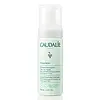What's inside
What's inside
 Key Ingredients
Key Ingredients

 Benefits
Benefits

 Concerns
Concerns

 Ingredients Side-by-side
Ingredients Side-by-side

Water
Skin ConditioningGlycerin
HumectantAcrylates Copolymer
Potassium Cocoyl Glycinate
Disodium Cocoamphodiacetate
CleansingPotassium Cocoate
EmulsifyingSodium Cocoyl Alaninate
Panthenol
Skin Conditioning1,2-Hexanediol
Skin ConditioningSodium Chloride
MaskingSodium Hydroxide
BufferingSodium Methyl Cocoyl Taurate
CleansingCaprylyl Glycol
EmollientZea Mays Starch
AbsorbentMicrocrystalline Cellulose
AbsorbentMannitol
HumectantButylene Glycol
HumectantGlycoproteins
Skin ConditioningHydroxypropyl Starch Phosphate
Hexylene Glycol
EmulsifyingSodium Phytate
Gluconolactone
Skin ConditioningEDTA
Tocopheryl Acetate
AntioxidantCI 77289
Cosmetic ColorantWater, Glycerin, Acrylates Copolymer, Potassium Cocoyl Glycinate, Disodium Cocoamphodiacetate, Potassium Cocoate, Sodium Cocoyl Alaninate, Panthenol, 1,2-Hexanediol, Sodium Chloride, Sodium Hydroxide, Sodium Methyl Cocoyl Taurate, Caprylyl Glycol, Zea Mays Starch, Microcrystalline Cellulose, Mannitol, Butylene Glycol, Glycoproteins, Hydroxypropyl Starch Phosphate, Hexylene Glycol, Sodium Phytate, Gluconolactone, EDTA, Tocopheryl Acetate, CI 77289
Water
Skin ConditioningGlycerin
HumectantSodium Cocoyl Glutamate
CleansingCaprylyl/Capryl Glucoside
CleansingCocamidopropyl Betaine
CleansingCoco-Betaine
CleansingCaprylyl Glycol
EmollientCitric Acid
BufferingPotassium Sorbate
PreservativeSodium Cocoyl Isethionate
CleansingSodium Methyl Cocoyl Taurate
CleansingSodium Chloride
MaskingSodium Phytate
Butylene Glycol
HumectantChamomilla Recutita Flower Extract
MaskingLinalool
PerfumingSalvia Officinalis Leaf Extract
CleansingCitronellol
PerfumingVitis Vinifera Fruit Extract
Skin ConditioningParfum
MaskingWater, Glycerin, Sodium Cocoyl Glutamate, Caprylyl/Capryl Glucoside, Cocamidopropyl Betaine, Coco-Betaine, Caprylyl Glycol, Citric Acid, Potassium Sorbate, Sodium Cocoyl Isethionate, Sodium Methyl Cocoyl Taurate, Sodium Chloride, Sodium Phytate, Butylene Glycol, Chamomilla Recutita Flower Extract, Linalool, Salvia Officinalis Leaf Extract, Citronellol, Vitis Vinifera Fruit Extract, Parfum
 Reviews
Reviews

Ingredients Explained
These ingredients are found in both products.
Ingredients higher up in an ingredient list are typically present in a larger amount.
Butylene Glycol (or BG) is used within cosmetic products for a few different reasons:
Overall, Butylene Glycol is a safe and well-rounded ingredient that works well with other ingredients.
Though this ingredient works well with most skin types, some people with sensitive skin may experience a reaction such as allergic rashes, closed comedones, or itchiness.
Learn more about Butylene GlycolCaprylyl Glycol is a humectant and emollient, meaning it attracts and preserves moisture.
It is a common ingredient in many products, especially those designed to hydrate skin. The primary benefits are retaining moisture, skin softening, and promoting a healthy skin barrier.
Though Caprylyl Glycol is an alcohol derived from fatty acids, it is not the kind that can dry out skin.
This ingredient is also used as a preservative to extend the life of products. It has slight antimicrobial properties.
Learn more about Caprylyl GlycolGlycerin is already naturally found in your skin. It helps moisturize and protect your skin.
A study from 2016 found glycerin to be more effective as a humectant than AHAs and hyaluronic acid.
As a humectant, it helps the skin stay hydrated by pulling moisture to your skin. The low molecular weight of glycerin allows it to pull moisture into the deeper layers of your skin.
Hydrated skin improves your skin barrier; Your skin barrier helps protect against irritants and bacteria.
Glycerin has also been found to have antimicrobial and antiviral properties. Due to these properties, glycerin is often used in wound and burn treatments.
In cosmetics, glycerin is usually derived from plants such as soybean or palm. However, it can also be sourced from animals, such as tallow or animal fat.
This ingredient is organic, colorless, odorless, and non-toxic.
Glycerin is the name for this ingredient in American English. British English uses Glycerol/Glycerine.
Learn more about GlycerinChances are, you eat sodium chloride every day. Sodium Chloride is also known as table salt.
This ingredient has many purposes in skincare: thickener, emulsifier, and exfoliator.
You'll most likely find this ingredient in cleansers where it is used to create a gel-like texture. As an emulsifier, it also prevents ingredients from separating.
There is much debate on whether this ingredient is comedogenic. The short answer - comedogenic ratings don't tell the whole story. Learn more about comegodenic ratings here.
The concensus about this ingredient causing acne seems to be divided. Research is needed to understand if this ingredient does cause acne.
Scrubs may use salt as the primary exfoliating ingredient.
Learn more about Sodium ChlorideThis gentle cleansing and foaming ingredient is known for leaving a smooth feeling in skin and hair. It is made using coconut oil.
According to the manufacturer, it is soluble in water and has resistance to hard water, acid, and alkali.
Due to its coconut base, it may not be Malassezia folliculitis safe.
Learn more about Sodium Methyl Cocoyl TaurateSodium Phytate is the synthetic salt form of phytic acid. Phytic acid is an antioxidant and can be found in plant seeds.
Sodium Phytate is a chelating agent. Chelating agents help prevent metals from binding to water. This helps stabilize the ingredients and the product.
Water. It's the most common cosmetic ingredient of all. You'll usually see it at the top of ingredient lists, meaning that it makes up the largest part of the product.
So why is it so popular? Water most often acts as a solvent - this means that it helps dissolve other ingredients into the formulation.
You'll also recognize water as that liquid we all need to stay alive. If you see this, drink a glass of water. Stay hydrated!
Learn more about Water